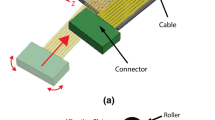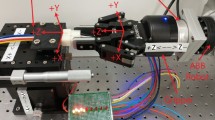Abstract
In this study, a method for the electric connector-mating process in a wiring harness assembly system is proposed. In connector-assembly tasks, grasping the electric connector is a crucial step. Therefore, a cable connector-feeding system is developed to align cable connectors so that they can be grasped straight and held firmly by the robot. After the grasping problems are solved, a tilt strategy with impedance control is used to overcome the position errors caused by the vision system. The location of the connector header (Female part of connector) is detected using visual servoing with markers. Then, impedance control is adopted to achieve compliant contact motion and minimize position/orientation errors. The performance of the proposed electric connector-assembly strategy is evaluated by a series of experiments using a six-degree of freedom industrial robot equipped with a force/torque sensor and an eye-in-hand camera.
Similar content being viewed by others
References
R. Lasky, The printed circuit board: More important now than ever, http://www.indium.com/blog/the-printed-circuitboard-more-important-now-than-ever.php.
F. Chen, F. Cannella, H. Huang, H. Sasaki and T. Fukuda, A study on error recovery search strategies of electronic connector mating for robotic fault-tolerant assembly, Journal of Intelligent Robotic Systems, 81 (2) (2016) 257–271.
J. Huang, P. Di, T. Fukuda and T. Matsuno, Fault-tolerant mating process of electric connectors in robotics wiring harness assembly systems, 7th World Congress on Intelligent Control and Automation (WCICA) (2008) 2339–2344.
J. Huang, T. Fukuda and T. Matsino, Model-based intelligent fault detection and diagnosis for mating electric connectors in robotic wiring harness assembly systems, IEEE/ASME Transactions on Mechatronics, 13 (1) (2008) 86–94.
B. Sun, F. Chen, H. Sasaki and T. Fukuda, Robotic wiring harness assembly system for fault-tolerant electric connectors mating, International Symposium on Micro-Nano Mechatronics and Human Science (MHS) (2010) 202–205.
D. Holz, M. Nieuwenhuisen, D. Droeschel, J. Stuckler, A. Berner, J. Li, R. Klein and S. Behnke, Active recognition and manipulation for mobile robot bin picking, Springer Tracts in Advanced Robotics (STAR), 94 (2014) 133–153.
F. Chaumette and S. Hutchinson, Visual servo control. Part I: Basic approaches, IEEE Robotics and Automation Magazine, 13 (4) (2006) 82–90.
D. E. Whitney, Mechanical assemblies, Oxford University Press, New York, USA (2004) 253–292.
H. C. Song, Y. L. Kim and J. B. Song, Guidance algorithm for complex-shape peg-in-hole strategy based on geometrical information and force control, Advanced Robotics, 30 (8) (2016) 552–563.
J. S. Oh and J. H. Oh, A modified perturbation/A modified perturbation/correlation method for force-guided assembly, Journal of Mechanical Science and Technology, 29 (12) (2015) 5437–5446.
Molex, http://www.molex.com/molex/products/group?key=connectors&channel=products.
Visual Servoing Platform, https://visp.inria.fr/.
B. Siciliano, L. Sciavicco, L. Villani and G. Oriolo, Robotics modelling, planning and control, Springer-Verlag London (2009) 363–405.
G. D. Glosser and W. S. Newman, The implementation of a natural admittance controller on an industrial manipulator, IEEE International Conference on Robotics and Automation, 2 (1994) 1209–1215.
S. R. Chhatpar and M. S. Branicky, Search strategies for peg-in-hole assemblies with position uncertainty, IEEE/RSJ International Conference on Intelligent Robots and Systems, Maui, USA (2001) 1465–1470.
S. Calinon, Robot programming by demonstration: A probabilistic approach, EPFL/CRC press, Boca Raton, USA (2009) 31–73.
Author information
Authors and Affiliations
Corresponding author
Additional information
Recommended by Associate Editor Sangyoon Lee
Hee-Chan Song received his B.S. and M.S. degrees in mechanical engineering from Chung-ang University in 2007 and Yonsei University in 2010, respectively. He is now enrolled in the Mechanical Engineering doctoral program at Korea University. His research interests include machine vision and force control of robotic systems for machining and assembly.
Jae-Bok Song received his B.S. and M.S. degrees in mechanical engineering from Seoul National University in 1983 and 1985, respectively. He was awarded his Ph.D. degree from M.I.T. in 1992. Dr. Song is currently a Professor at the School of Mechanical Engineering of Korea University. He has served as a Director of the Intelligent Robotics Laboratory from 1993. His research interests include safe manipulators and the design and control of robotic systems.
Rights and permissions
About this article
Cite this article
Song, HC., Kim, YL., Lee, DH. et al. Electric connector assembly based on vision and impedance control using cable connector-feeding system. J Mech Sci Technol 31, 5997–6003 (2017). https://doi.org/10.1007/s12206-017-1144-7
Received:
Revised:
Accepted:
Published:
Issue Date:
DOI: https://doi.org/10.1007/s12206-017-1144-7




